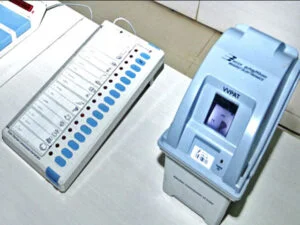
Why in news?
- In a landmark decision, the Supreme Court of India recently reaffirmed the integrity and reliability of the electronic voting machines (EVM) system, dismissing calls for a return to the paper ballot system.
- The ruling, stemming from the Association of Democratic Reforms v. Election Commission of India Case, 2024, not only upheld the use of EVMs but also maintained the current random 5% verification of votes through Voter Verifiable Paper Audit Trail (VVPAT) slips in Assembly constituencies.
- While rejecting the demand for 100% cross-verification, the Court issued directives to strengthen the existing electoral framework.
Supreme Court’s Observations on electronic voting machines and VVPATs:
- The Court emphasized the lack of substantial evidence to question the integrity of the current polling system, especially with the implementation of VVPATs.
- Citing legal precedents, including the 2013 Subramanian Swamy v. Election Commission of India case, the Court underscored the importance of a paper trail for ensuring fair elections.
- Addressing concerns about the neutrality of EVM microcontrollers, the Court affirmed that these components are impartial, merely recording voters’ selections without favoring any political entity. Additionally, the Court highlighted the stringent security measures in place, such as the Unauthorized Access Detection Mechanism (UADM), which renders the EVM permanently disabled in case of unauthorized tampering attempts.
Historical Context and Evolution of EVMs in India:
- The journey of electronic voting machines in India dates back to the late 1970s when the concept was conceived and a prototype developed.
- Despite initial skepticism, EVMs were gradually embraced, leading to their formal introduction in elections in the 1980s.
- Legal amendments and technical advancements paved the way for widespread adoption, with EVMs becoming a cornerstone of India’s electoral process by the early 2000s.
Advantages of EVMs Over Paper Ballots:
- Accuracy and Reduced Errors: electronic voting machines eliminate human errors associated with manual counting, ensuring precise tabulation of votes and minimizing discrepancies.
- Efficiency and Speed: Compared to the time-consuming process of manual counting, EVMs enable faster tabulation and declaration of results, streamlining the electoral process.
- Environmental Sustainability: By reducing paper usage, EVMs contribute to environmental conservation, aligning with global efforts to promote sustainable practices.
- Enhanced Security Measures: Advanced encryption and tamper detection mechanisms make EVMs more secure and less susceptible to fraud, ensuring the integrity of election outcomes.
Conclusion
- The Supreme Court’s endorsement of electronic voting machines underscores their crucial role in upholding the democratic principles of transparency, accuracy, and efficiency in India’s electoral system.
- While acknowledging the need for continuous improvement and vigilance, the Court’s decision reaffirms the trust placed in electronic voting machines as a reliable tool for conducting free and fair elections.
- As India continues its journey of democratic governance, the evolution and refinement of electoral technologies like EVMs remain essential in ensuring the integrity and credibility of the electoral process.
- In conclusion, the adoption of EVMs represents a significant milestone in India’s electoral history, marking a departure from traditional paper ballots towards a more efficient, secure, and transparent voting system.
People also ask
Q1: What is an Electronic Voting Machine (EVM)?
Ans: An Electronic Voting Machine (EVM) is a device used to record votes electronically in elections. It allows voters to select their preferred candidates by pressing buttons corresponding to the candidates’ names or symbols.
Q2: How do electronic voting machines work?
Ans: electronic voting machines work by storing candidates’ names or symbols along with their respective buttons. When a voter selects a candidate by pressing the button, the machine records the vote electronically.
Q3: Are EVMs secure?
Ans: Yes, EVMs incorporate various security features such as encryption, tamper detection mechanisms, and unauthorized access detection to ensure the integrity and confidentiality of the voting process.
Q4: Can EVMs be tampered with?
Ans: EVMs are designed with multiple layers of security to prevent tampering. Any unauthorized attempt to access the EVM’s microcontroller or memory triggers the Unauthorized Access Detection Mechanism (UADM), rendering the machine permanently disabled.